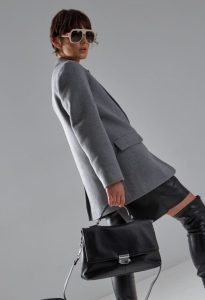 But is it anywhere, this notorious freedom of choice? Social surveys confirm that even if the company does not officially require the wearing of certain clothes, called a dress code, then the unofficially unpresentable appearance of an employee may well serve as a hidden reason for his dismissal.
But is it anywhere, this notorious freedom of choice? Social surveys confirm that even if the company does not officially require the wearing of certain clothes, called a dress code, then the unofficially unpresentable appearance of an employee may well serve as a hidden reason for his dismissal.
Are you lucky, you work for yourself, outside of any companies, a free money hunter? But your earnings depend on other people who serve as sources of income by purchasing the products and services you offer. Have you ever thought about how clothes in contact with people can increase or decrease profits, making it possible to earn more or less? Or is its impact on success unreasonably exaggerated?
Dress code is a symbol of success
Brand – this concept has become a symbol of our time. Any company tries to stand out among the general vast number of competitors, inventing a distinctive trademark and recognizable corporate identity. The dress code is the main corporate image of any company, allowing you to strengthen your reputation in the market. Social surveys confirm that 97% of managers are in favor of adopting their own style of dress.
Dress code (translated as “clothing code”) is the form of clothing prescribed by the company for its employees and the rules for wearing it. Special attire is regulated for various corporate events, visits to various public institutions, presence at certain events. Each employee must strictly comply with the company’s requirements for his appearance and appearance. This clothing cannot be called a uniform, it is purely individual, but is selected taking into account the rules of the company, often depends on its main activity.
Everyone is accustomed to the strict appearance of bank employees. If people in banks were met by people in extravagant attire of people of creative professions or sexual minorities, who would want to entrust such an institution with their money, which they managed to earn and save with difficulty? Evaluating the dress code by the appearance of the company’s employees, future partners draw a conclusion about its condition, role, weight, culture, respect for customers.
If a representative of a large corporation shows up for a pretentious meeting, which should end with the signing of an agreement, in jeans, slippers and an unbuttoned loose-fitting shirt …. Does he have a chance to convince future partners to sign an agreement with his company and help her earn money by signing a lucrative contract? How extraordinary a person must be if he manages to do this, because in our society they always “meet by clothes” and immediately see them off without bothering to assess the mind if the clothes do not meet the prescribed requirements.
What is included in the concept of dress code?
Cleanliness and neatness of clothing is a matter of course for a representative of any profession. You should not appear at the workplace in the same attire two days in a row. There is even a saying about this: “You should not put on yesterday.” Each person should have several suits, individual items of which (jackets, vests, trousers, skirts) can be easily combined with each other and with other wardrobe items in color, style, and style.
The heads of large corporations, when hiring employees, can, adopting foreign traditions, present them with requirements for appearance, the listing of which takes several pages of the contract. As a rule, in such companies such excessive strictness is compensated by very high earnings, for the sake of which ladies agree to wear a classic suit, tights, and closed shoes in the summer thirty-degree heat.
Employees are introduced to a list of things that are unacceptable to appear in them in the office. Women should not wear excessively short skirts, tight jeans, sundresses with bare shoulders, blouses-tops, the length of which ends above the waist. Men have their own requirements, the main of which is the obligatory wearing of a tie and fastening of a shirt with top buttons.
Social surveys show that, according to the employees themselves, the dress code is convenient. He disciplines well and even improves performance. Putting on special office clothes, a person immediately tunes in to a business tone.
The dress code, in a slightly different form than in the officialdom of corporations, applies to:
some national attire (Jewish men are recognized by special hats),
the appearance of representatives of various religions (everyone is familiar with the specific requirements for Muslim women’s clothing),
social classes (noticeably stratifying society into property and non-property layers),
representatives of sexual orientation.
In general, society satisfies this situation, because by clothes you can immediately conclude who is in front of you, how to behave with this person, what to expect from him.
